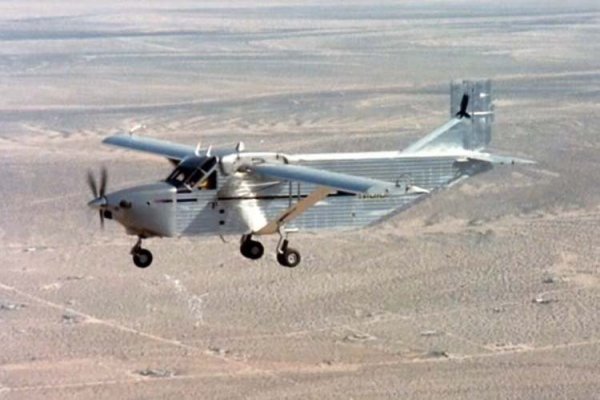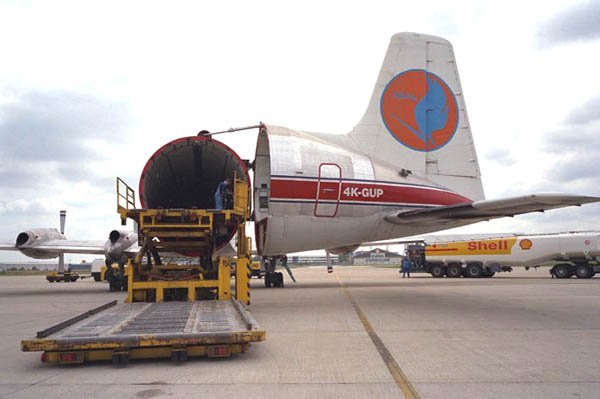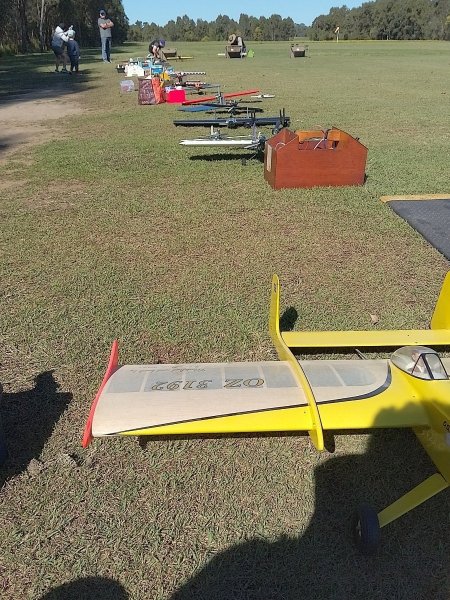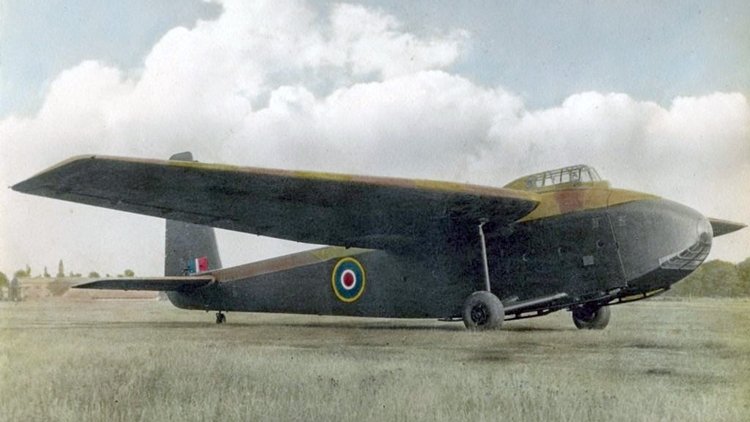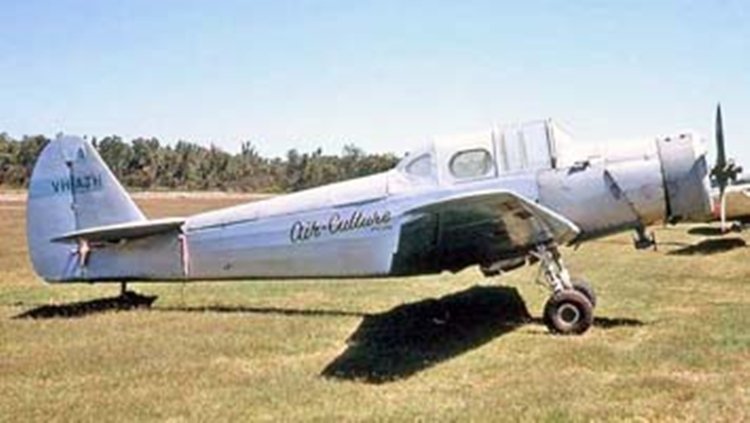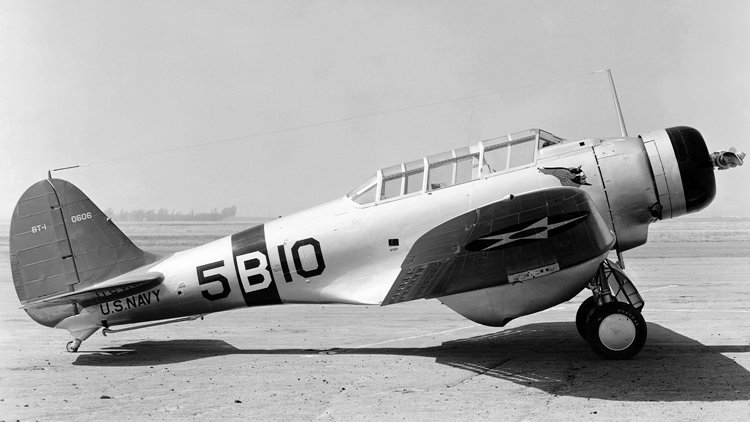-
Posts
7,576 -
Joined
-
Last visited
-
Days Won
67
Content Type
Profiles
Forums
Gallery
Downloads
Blogs
Events
Store
Aircraft
Resources
Tutorials
Articles
Classifieds
Movies
Books
Community Map
Quizzes
Videos Directory
Everything posted by red750
-
The Victa Aircruiser was a 1960s Australian four-seat touring monoplane designed by Henry Millicer and built by Victa. It was not put into production by Victa, and the rights were sold to AESL in 1969. Following the success of the earlier Airtourer, Millicer designed a four-seat version which he called the Aircruiser. The prototype registered VH-MVR first flew on 18 July 1966. Like the Airtourer it was a low-wing monoplane with a fixed nosewheel landing gear and powered by a 210 hp (157 kW) Continental IO-360-H piston engine. Rather than the sliding clear Perspex canopy of the Airtourer, the four-seat Aircruiser had a fixed cabin roof with a single "car type" door on the left hand side. Although Victa completed certification testing, no production of the Aircruiser followed, as Victa closed down its Aviation Division after failing to get financial assistance from the Australian government. Both Victa and Transavia Corporation had requested subsidies for Australian-designed and -built light aircraft, with Victa seeking a subsidy of up to 60% of the factory cost. Following the sale of the design rights of the Airtourer to Aero Engine Services Limited (AESL) of New Zealand, the rights to the Aircruiser were also sold to AESL in 1969. AESL's Chief Designer Pat Monk re-designed the aircraft as the AESL CT/4 Airtrainer, a fully aerobatic (+6G, -3G) military trainer. In 2013 Brumby Aircraft Australia announced the company had purchased the type certificate for the Victa Aircruiser to be developed into the Brumby Aircruiser.
-
The Grumman F2F was a single-engine, biplane fighter aircraft with retractable undercarriage, serving as the standard fighter for the United States Navy between 1936 and 1940. It was designed for both carrier- and land-based operations. Grumman's success with the two-seat FF-1, which was significantly faster than even the single-seat fighters of its time, resulted in a contract for the single-seat XF2F-1. Armed with two 0.30 in (7.62 mm) machine guns above the cowl, the new design also incorporated watertight compartments to reduce weight and improve survivability in the event of a water landing. The prototype first flew on 18 October 1933, equipped with the experimental 625 hp (466 kW) XR-1534-44 Twin Wasp Junior radial engine, and reached a top speed of 229 mph (369 km/h) at 8,400 ft (2,600 m) – 22 mph (35 km/h) faster than the FF-1 at the same altitude. Maneuverability also proved superior to the earlier two-seat aircraft. The Navy ordered 54 F2F-1 fighters on 17 May 1934, with the first aircraft delivered 19 January 1935.[citation needed] One additional aircraft (BuNo 9997) was ordered to replace one which crashed on 16 March 1935, bringing the total to 55, with the final F2F-1 delivered on 2 August 1935.[citation needed] The F2F-1 had a relatively long service life for the time, serving in front-line squadrons from 1935 to late 1939, when squadrons began to receive the F3F-3 as a replacement. By September 1940, the F2F had been completely replaced in fighter squadrons and was relegated to training and utility duties. The last F2F-1s were stricken from the list of naval aircraft in early 1943. Variants XF2F-1 United States Navy designation for the Grumman Model G-8 prototype with a 625 hp (466 kW) XR-1534-44 Twin Wasp Junior radial engine, one built F2F-1 Production variant with a 700 hp (522 kW) R-1535-72 Twin Wasp Junior radial engine, 55 built.
-
The Hawk GafHawk ("General Aviation Freighter") was a small, turboprop-powered freighter aircraft developed in the United States in the 1980s but which only flew in prototype form. It was designed by Hawk International as a means of transporting drilling equipment in and out of remote locations, and was designed to be simple, rugged, and have good STOL and rough-field performance. The resulting design was a boxy aircraft with a rectangular-section fuselage with a high-set tail and rear loading ramp. The high aspect-ratio wings were high-set and braced with struts. The landing gear was fixed and of tricycle configuration, with the main units having dual wheels. Certification proved elusive, however, and Hawk eventually abandoned the project without building any other examples.
-

Piper Archer down SW Sydney 22/08/2024
red750 replied to planedriver's topic in Aircraft Incidents and Accidents
Observers said he aimed for the trees to avoid school kids. -
A Jetstar passenger has been arrested at Melbourne Airport after forcing open a cabin door and jumping out of the plane. The drama unfolded on Thursday morning just after 10am when flight JQ507 arrived from Sydney. Jetstar confirmed to Yahoo News that the passenger exited the plane by deploying an emergency exit. "We can confirm that a passenger opened the emergency exit door after arrival into Melbourne, which automatically deployed the slide," a spokesperson said. The plane was parked at a boarding gate at the time. The reason behind the man's impulsive act is not currently clear, however, photos show the man clinging to one of the plane's engines before he landed on the tarmac. Ground staff were able to restrain the passenger before the Australian Federal Police intervened. The ground staff have since been praised for their swift response to the incident. "Melbourne Airport is proud of the exceptional response from ground crew, which meant there was no immediate danger to other passengers or airport staff," a spokesperson from Melbourne Airport said. Full report.
-
The Conroy Skymonster (CL-44-0) is a 1960s United States specialized cargo aircraft based on the Canadair CL-44 freighter, with an outsize fuselage. The aircraft was designed by John M. Conroy as a transport aircraft that could be used to ferry three Rolls-Royce RB.211 jet engines from Belfast, Northern Ireland, to Palmdale, California, United States. The engines were to be installed on the Lockheed L-1011 TriStar airliner. The Skymonster was derived from a Canadair CL-44 freighter, in turn a derivative of the Bristol Britannia. It features an enlarged fuselage, like the Aero Spacelines Mini Guppy, which was produced by Jack Conroy's previous company, Aero Spacelines. The conversion was performed outdoors, under covered scaffolding, at the Santa Barbara California airport. The nose section was built using foam covered with fiberglass, while the larger fuselage was constructed using conventional aluminum structure. The Skymonster first flew on 26 November 1969, under the US registration "N447T". The CL-44 from which it had been converted also bore this same registration, and was previously operated by the Flying Tiger Line. Only one prototype was built. Another one was ordered, but the CL-44 on which it was to be based crashed before delivery. In 1970, the prototype was leased by Transmeridian Air Cargo, who gave it the name "Skymonster". Despite its being renamed "Bahamas Trader" later on, the name Skymonster stuck, and it is now commonly known as this. In 1978, it was bought by British Cargo Airlines. In 1982, it went to HeavyLift Cargo Airlines, who re-registered it with the Irish registration EI-BND. The aircraft went into storage in 1993, but was bought by a leasing company only two months later and leased to Buffalo Airways. According to Mikey McBryan General Manager for Buffalo Airways in Yellowknife Canada, this Buffalo Airways was a different operator and had no connection to the Canadian company. Its next lease was to Azerbaijan Airlines in 1997, under the registration 4K-GUP. In March 1998, it was leased to Baku Express. In August 1998 it went to First International Airlines and was registered 9G-LCA. In 1999, it was placed into storage, initially in the US, but then it was flown to Bournemouth Airport, UK, where it was scheduled to be scrapped. In December 2006 the aircraft was registered in the Philippines (RP-C8023) and was being prepared for service in Australia.[3] As of March 2008, the Skymonster was still at Hurn. In August 2008, it was reported that the aircraft was in the process of being scrapped, however as of September this was on hold amid further rumours about donation to a museum in Germany. On 14 January 2010, Bournemouth International Airport Limited offered the aircraft for sale in The London Gazette. After a long period of storage, activity was again seen around the Skymonster during the summer of 2013. In July 2013 it was registered N447FT in the United States to a Jordan Harlan Wayne, but has since been deregistered. As of 21 May 2021 the Skymonster remains at Bournemouth International Airport, moved from its original parking spot to make way for airport development.
-
If you are using Windows, open the photo (say, Xxxxx) in Paint and click the rotate option, select left or right as required and Save As and label as Xxxxx 1.jpg. I use a photo editor, but the result is the same.
-
-
Dornier Do K3 Crew: two Capacity: ten Length: 16.65 m (54 ft 7.5 in) Wingspan: 25 m (82 ft 0.25 in) Height: 4.55 m (14 ft 11.25 in) Wing area: 89 m2 (958.02 sq ft) Empty weight: 4,265 kg (9,403 lb) Gross weight: 6,200 kg (13,669 lb) Powerplant: 4 × Walter Castor radial piston engine , 227 kW (305 hp) each Performance Maximum speed: 230 km/h (143 mph, 124 kn) Range: 800 km (497 mi, 432 nmi)
-
The Dornier Do K was a German commercial passenger and freight monoplane, designed by Claude Dornier and built by Dornier Flugzeugwerke. Only three prototypes of different designs were built and the type was not a commercial success. Do K1 The first Dornier Do K was the K1 which first flew on 7 May 1929. The K1 was a conventionally-braced high-wing monoplane, powered by a single nose-mounted 510 hp (380 kW) licence-built Bristol Jupiter VI radial engine, and had a conventional landing gear with a tailskid. The square-section fuselage had an enclosed cockpit for two with a cabin behind for freight or eight passengers. Test flights showed that performance was poor and the aircraft was redesigned. Do K2 The Do K2 flew in December 1929 with similar wings and fuselage but had a changed landing gear and four 240 hp (179 kW) Gnome-Rhone Titan radial engines. The four engines were strut mounted on each side of the fuselage in tandem pairs, one in tractor configuration and the other as a pusher. Although the aircraft had an increase in available power, the performance was little improved on the K1. Do K3 The K3 was a complete rethink of the design. The braced wing was replaced with a cantilever wing of larger span. The fuselage was changed to oval and stretched for two extra passengers and the tailskid was replaced with a tailwheel and the main units were enclosed in fairings. The four engines were in the same tandem arrangement as the K2, but located lower on the fuselage and changed to 305 hp (227 kW) Walter Castor radial engines. The performance was greatly improved but still provoked little interest and no others were built.
-
Ligeti Stratos Further to page 6 entry, Powerplant: 1 × König SD 570 4 cylinder, 2 stroke, 21 kW (28 hp) Maximum speed: 200 km/h (120 mph, 110 kn) Cruise speed: 97 km/h (60 mph, 52 kn) Stall speed: 58 km/h (36 mph, 31 kn) Never exceed speed: 270 km/h (170 mph, 150 kn)
-
Otto Celera 500L Cruise speed: 400 kn (460 mph, 740 km/h) estimated minimum Range: 4,500 nmi (5,200 mi, 8,300 km) Service ceiling: 30,000 ft (9,100 m) Maximum glide ratio: 22:1
-
Scaled Composites Model 81 Catbird Maximum speed: 238 kn (274 mph, 441 km/h) Cruise speed: 218 kn (251 mph, 404 km/h) Rate of climb: 2,000 ft/min (10 m/s)
-
The Mitsubishi Ki-21, formal designation "Type 97 Heavy Bomber" (九七式重爆撃機, Kyūnana-shiki jūbakugekiki) was a Japanese heavy bomber during World War II. It began operations during the Second Sino-Japanese War participating in the Nomonhan Incident, and in the first stages of the Pacific War, including the Malayan, Burmese, Dutch East Indies and New Guinea Campaigns. It was also used to attack targets as far-flung as western China, India and northern Australia. The Allies designated it under the reporting names "Sally" /"Gwen". In 1936, the Imperial Japanese Army Air Service issued a requirement for a new heavy bomber to replace both the Ki-20 (Army Type 92 Heavy Bomber) and the Ki-1 (Army Type 93 Heavy Bomber). The design called for a crew of at least four, top speed of 400 km/h (250 mph), endurance of at least five hours, and a bombload of 750 kg (1,650 lb). The design parameters were very ambitious for the mid-1930's; few twin-engine bombers anywhere in the world could exceed such performance at that time. Both Mitsubishi and Nakajima were asked to build two prototypes each, a further proposal from Kawasaki was rejected. The Mitsubishi design was an all-metal mid-wing cantilever monoplane with retractable landing gear, ventral bomb bay and two radial engines. The first prototype flew on 18 December 1936, with the second prototype, which differed in replacing the dorsal turret of the first prototype with a long greenhouse canopy, following later in the month. In the resulting competition, Mitsubishi's Ki-21 and Nakajima's Ki-19 were found to be similar, with the Ki-21 having better performance, while the Nakajima design was a better bombing platform and had more reliable engines. In order to make a final decision, two further prototypes were ordered from both Mitsubishi and Nakajima, with Mitsubishi instructed to change its own 615 kW (825 hp) Mitsubishi Ha-6 radial engines for the Nakajima Ha-5 engines used by the Nakajima design and vice versa, while the Ki-21 gained a revised glazed nose similar to that of the Ki-19 and revised tail surfaces. Thus modified, the Ki-21 proved superior and was ordered into production in November 1937 as the "Army Type 97 Heavy Bomber Model 1A". Production aircraft began to enter service in August 1938, supplementing and then replacing the Fiat BR.20 bombers which had been purchased as an interim measure. Several improved versions followed before the production of the type ended in September 1944. A total of 2,064 aircraft were built, 1,713 by Mitsubishi and 351 by Nakajima. Variants Ki-21 Prototype models with various engines and armament combinations for evaluation. Final version with Nakajima Ha-5 engine. 8 built Ki-21-Ia (Army Type 97 Heavy Bomber, Model IA) First production model, with 634 kW (850 hp) Nakajima Ha-5-kai engines. Most were built by Mitsubishi, 143 manufactured by Nakajima Ki-21-Ib (Army Type 97 Heavy Bomber, Model IB) Improved version with additional 7.7 mm (0.303 in) machine guns, larger bomb compartment and flaps, redesigned tail. 120 built by Mitsubishi, 351 (including Ki-21 Ib and Ic) by Nakajima Ki-21-Ic (Army Type 97 Heavy Bomber, Model IC) Improved type with one additional 7.7 mm (0.303 in) machine gun, increased fuel capacity, 160 built by Mitsubishi Ki-21-II Evaluation model with more powerful engines, 4 built Ki-21-IIa (Army Type 97 Heavy Bomber, Model IIA) Production model based on Ki-21-II, 590 built Ki-21-IIb (Army Type 97 Heavy Bomber, Model IIB) Final production version based on Ki-21-IIa with modified canopy, clear upper cabin replaced by rotating turret, 688 built. MC-20-I (Army Type 100 Transport, Model I) Unarmed civilian transport version, converted from Ki-21-Ia; approximately 100 aircraft were converted.
-
The General Aircraft Limited GAL.49 Hamilcar or Hamilcar Mark I was a large British military glider produced during the Second World War, which was designed to carry heavy cargo, such as the Tetrarch or M22 Locust light tank. When the British airborne establishment was formed in 1940 by the order of Prime Minister Winston Churchill it was decided to develop a large glider which would be able to transport heavy equipment in support of airborne troops. General Aircraft Limited were chosen in January 1941 to develop this glider, which they designated the GAL.49 'Hamilcar'. It was designed to transport a light tank or two Universal Carriers. A number of problems, which included vacillation by the War Office on the number of gliders it wanted and poor management by GAL, led to delays in the production of the Hamilcar and it was not until mid-1943 that the first production glider was assembled. These problems were only partially solved and production of the glider continued to be slow, hampered by difficulties in finding suitable locations to store and construct them once their parts were produced. A total of 344 Hamilcars had been built when production ended in 1946. Hamilcars were used on three occasions,and only in support of British airborne forces. They first saw action in June 1944, when approximately thirty were used to carry Ordnance QF 17 pounder anti-tank guns, transport vehicles and Tetrarch light tanks into Normandy in support of British airborne forces during Operation Tonga. In September 1944 a similar number of Hamilcars were used to transport anti-tank guns, transport vehicles and supplies for airborne troops as part of Operation Market Garden. They were used a third and final time in March 1945 during Operation Varsity when they transported M22 Locust light tanks and other supplies. The gliders proved to be successful in all three operations, although their slow speed and large size made them easy targets for anti-aircraft fire, which resulted in a number of gliders being damaged or destroyed. A powered variant of the Hamilcar was produced, the Hamilcar Mark X, to extend the range of the Hamilcar so it could serve in the Pacific War; the conflict in the Pacific ended before the design could see combat. The Hamilcar was constructed primarily from wood, mainly birch and spruce, with fabric-covered plywood forming the skin, and high grade steel reinforcement beams in critical areas. It had a wingspan of 110 feet (34 m), a length of 68 feet (21 m) and a height of 20 feet (6.1 m) to the top of the fin with the tail down. It weighed 18,400 pounds (8,300 kg) when empty, and could transport a military load of 17,600 pounds (8,000 kg) to give a total weight of 36,000 pounds (16,000 kg). The whole aircraft was broken down into smaller sections for transport. It was so large and heavy that it required the largest and most powerful aircraft to pull it off the airfield and subsequently tow it; four-engined bombers were used, most frequently the Handley Page Halifax. Both wing and cockpit were set above the fuselage to provide the greatest amount of room for the cargo compartment, and to ensure that they did not interfere with the loading of vehicles; the compartment measured approximately 32 feet 31.5 inches (10.554 m), 7 feet 10.5 inches (2.400 m) inches wide and between 6 feet (1.8 m) and 7 feet 7 inches (2.31 m) inches in height. The nose of the glider was hinged and opened to the side for ease of loading vehicles and cargo, and the crew of two pilots were seated in tandem in a cockpit on the top of the fuselage, which was accessed via an internal ladder and was fifteen feet above ground; they were eventually protected by a bullet-proof windscreen and a plate of armour behind the second pilot. An intercom was also added to provide communication between the pilots and the personnel below them. An initial design feature, which was eventually removed prior to full-scale production, was the installation of an under-fuselage hatch which would allow the prone firing of a Bren light machine gun as the glider approached the landing zone. When the parts for a Hamilcar were completed and the glider was erected, it was flown to RAF North Luffenham in Rutland to have its specific cargo placed on board, and it was then flown to RAF Tarrant Rushton, which had been selected as the Hamilcar training and operational base in November 1943. It was not possible to tow the glider empty, so any empty gliders usually carried Universal Carriers or concrete blocks as ballast. For more information on the development, design, operational history and variants of the Hamilcar, click here.
-

Helicopter crash into Cairns hotel 12/08/2024
red750 replied to red750's topic in Aircraft Incidents and Accidents
How is this likely to affect the ASIC -
The Otto Celera 500L is a business and utility light aircraft developed by American startup, Otto Aviation. By November 2021, 55 successful test flights had been completed, as introduction is targeted for 2024–2025. It has a single RED A03 diesel piston engine in a pusher configuration and can seat six passengers. It is named after the latin word for 'fast,' celer. Otto Aviation Group, LLC was established in 2008 by Bill Otto to develop the Celera 500L. William Otto has been a research scientist at Los Alamos Scientific Labs, systems engineer then chief scientist at North American Aviation. Otto Aviation is privately funded since 2008 and is seeking a Series B fundraising round: 200 million dollars are needed for FAR Part 23 certification in three years. Construction of the airplane commenced in 2015. The aerodynamic prototype made its maiden flight in January 2018, and began performance testing in September 2019. Otto publicly announced the aircraft and its development program in August 2020, and noted that 31 test flights had been flown to date.[6] By then, a weight-optimized conforming prototype with cabin windows and longer landing gear was expected to fly within 18 months. FAA certification and deliveries are targeted for 2023–2025. By March 2021, the prototype had achieved over 35 hours of flight tests, interrupted by the pandemic until Q3 2021, before two additional flying prototypes join the program. By October 2021, the company had raised more than $50 million. The prototype should reach a fuel economy of 30 mpg‑US (7.8 L/100 km) in cruise, to be improved with integrated heat exchangers replacing radiators nacelles. A second turbo-compressor should allow reaching a 38,000 ft (12,000 m) altitude, and a third for 50,000 ft (15,000 m). In 2022, Otto announced a partnership with ZeroAvia to build a hydrogen-powered version of its aircraft. Introduction planned 2024-2025.
-
The Scaled Composites Model 81 Catbird is a high-efficiency five-seat single-engine all-composite general aviation aircraft designed by Burt Rutan. It is unusual in that it incorporates both a small forward wing and a small conventional horizontal stabilizer on the tail. The Catbird was designed by Burt Rutan while his company, Scaled Composites, was owned by Beechcraft. The design was intended to replace the long-produced Bonanza. The financial situation of Beech at the time, and competing projects, prevented consideration of commercial production. In 1988 Beechcraft sold Scaled Composites to the partnership of Rutan and the Wyman-Gordon Company, who also acquired the rights to a number of the designs, including Model 81 Catbird. The aircraft was stored inverted from the ceiling of Scaled Composites' Mojave hangar until April 2011. The aircraft was restored to flying condition by Zach Reeder, Jim Reed and Mike Melvill. Catbird's second first flight was July 7, 2011. Catbird holds the world record for speed over a closed circuit of 5,000 km without payload of 334.44 km/h, set in 2014 in Category C-1c, Landplanes with take-off weights from 1000 to 1750 kg. The aircraft won the CAFE Foundation's 1988 California CAFE 400 race flown by Mike Melvill, in which aircraft compete for performance efficiency, as measured by fuel consumption, speed and payload. Piloted by Dick Rutan, it subsequently won the 1993 CAFE Challenge with a record score and a speed of 210.73 mph (339.14 km/h), fuel consumption of 20.15 mpg (US miles and gallons) and a payload of 976.63 pounds (442.99 kg). In 2014, the Catbird set another record, for speed over a closed 2,000 km course, from Mojave to EAA AirVenture Oshkosh, with an average speed of 339.50 km/h (211 mph).
-

Helicopter crash into Cairns hotel 12/08/2024
red750 replied to red750's topic in Aircraft Incidents and Accidents
More details of the timeline. Cairns helicopter crash: The major unanswered questions about the helicopter tragedy - as astonishing timeline reveals how incident unfolded | Daily Mail Online WWW.DAILYMAIL.CO.UK New Zealander Blake Wilson was the pilot on board a Robinson 44 helicopter which smashed into the roof the DoubleTree by Hilton in Cairns -

Helicopter crash into Cairns hotel 12/08/2024
red750 replied to red750's topic in Aircraft Incidents and Accidents
Cairns helicopter crash: Blake Wilson identified as pilot behind the flight that crashed | Daily Mail Online WWW.DAILYMAIL.CO.UK The helicopter pilot who crashed a stolen aircraft into a waterfront hotel in Cairns was a young Kiwi who had only recently moved to Australia to begin a 'new adventure'. -
Cessna 407 The late 1950s and early ’60s saw a frenzy of aircraft development. Largely driven by military contracts that called for a specialized type dedicated to each role, variety abounded, and unique designs emerged to address the many military requirements of the era. Cessna was no exception, and it took an interesting approach to developing a new model in September 1959. Historically, Cessna would modify civilian types for military use. For example, the 310 became the U-3, the 185 became the U-17, and the 172 became the T-41. In the case of the 407, the company reversed the process, using the existing T-37 “Tweet” primary jet trainer as a starting point and modifying it for civilian use. By installing new engines and modifying the cabin section, it aimed to convert the two-place military trainer into a comfortable, four-place personal jet. There was some precedent for this new category of aircraft. Just seven months prior, French manufacturer Morane-Saulnier introduced the MS.760 Paris, a four-place jet with similar dimensions. With both military contracts and civilian sales secured, Morane-Saulnier appeared to have found multiple markets and would ultimately go on to build more than 200 examples. Never one to happily cede market share, Cessna observed that it could pursue the blossoming personal jet market and also possibly secure some additional military contracts with minimum investment. By utilizing many of the same components and tooling as the T-37, much of the necessary development work could be avoided. Building a full-scale wooden mock-up and beginning construction of the first prototype, the marketing group began a sales tour, pitching the concept at various locations around the U.S. Outwardly similar to the T-37, the 407 utilized the same tail section and wing as the jet trainer but repositioned the engine nacelles 9 inches outward to create more internal space. The cabin utilized this additional space to accommodate four passengers and their baggage. Occupants could easily step into the low-slung cabin without the need for separate steps or ladders, a welcome change from the MS.760, which required occupants to climb a stepladder and clamber into the cockpit from above—decidedly unsophisticated for the target customers of luxurious private jets. Ultimately, like some other intriguing concepts from Cessna, the 407 was not to be. The mock-up pictured was, in fact, a T-37 with a wooden cabin section. And while construction of actual cabin sections was underway, the entire 407 project was abandoned in favor of the massively successful Citation family, the first of which flew in 1969. Interestingly, the FAA registry shows that Cessna registered a 407 as N34267, with serial number 627, indicating the project was full steam ahead, right up until the end.
-

Helicopter crash into Cairns hotel 12/08/2024
red750 replied to red750's topic in Aircraft Incidents and Accidents
As he was, or had been an employee of Nautilas Aviation ground crew, one would assume he did. -
The company that owns the helicopter that crashed into a Cairns hotel early on Monday killing the pilot, the only occupant, and sparking the evacuation of 400 guests, says the flight was "unauthorised" and the chopper was taken from a hangar at Cairns Airport. The helicopter, a Robinson R44, was stolen by a member of the ground crew at Nautilas Aviation after having farewell drinks with a colleague before leaving for a promotion to a position in Torres Strait. He did not hold an Australian helicopter licence, but had held a New Zealand commercial helicopter licence.
-
The KS-3 agricultural aircraft was the forerunner of the Yeoman Cropmaster, and was built at Bankstown, NSW, by Kingsford Smith Aviation Services (KSAS) in the 1950s. KSAS was well versed with the Wackett, having been involved in overhauling some 50 ex-RAAF Wacketts for the Netherlands East Indies Air Force (NEIAF) in 1946. In 1957 KSAS modified a Wackett VH-AJB (c/n 274) to improve performance. In February 1957 further modifications were made and, following tests, another Wackett VH-AJH (c/n 283) was converted for agricultural use by the installation of a hopper in the front cockpit. First flight was made on 26 March 1957, and this aircraft, known as the KS-1, could carry a 295 kg (650 lb) payload. In August 1957 further modifications were made, including a new hopper and louvre box, and the KS-1 became known as the KS-2. The Chief Pilot of Airwork Pty Ltd of Perth, WA flew the aircraft and asked that the hopper be placed behind the pilot to improve visibility and for ease of loading, and a Wackett (c/n 363) was so converted. Following initial use of the aircraft for a period as noted, this Company recommended changes to the conversion to make it more suitable in its design role. The result was the KS-3, which had a completely re-designed fuselage and a modified wing. The hopper was placed in a hole cut out of the centre-section of the wooden wing, and the control system was re-designed to bypass the hopper, which was installed in what was previously the rear cockpit, which had a capacity of 13 m³/364 litres (459 sq ft/80 Imp gals) and was built of aluminium. Another Wackett VH-FBD¹ (c/n 299) was converted but this aircraft, along with the prototype PL-7 Tanker, was destroyed in a hangar fire at Bankstown on 17 January 1958. KSAS then reserved registrations VH-FBD to VH-FBM for the first production batch of ten aircraft. Another KS-3 VH-FBE (c/n 365) was completed and flown on 24 December 1957. A fourth Wackett (c/n 410) was converted, being test flown and registered on 27 June 1958, becoming VH-FBD². Surplus equipment was removed and, despite the installation of the 123 kw (165 hp) Warner Super Scarab engine, which was considered a little under-powered for this role, the aircraft was found to have a reasonable performance. First customer delivery was VH-FBF (c/n 375) to Airwork in Western Australia, this aircraft having been slightly damaged in the hangar fire referred to but, being repaired, flying for the first time on 21 February 1958. Later the KS-2 VH-AJH (c/n 283) was overhauled, brought up to KS-3 specifications, and bought by Airwork. All KS-3 Cropmasters were operated by Air Culture Pty Ltd, having been obtained from Airwork, in association with Yeoman Aviation Pty Ltd of Claremont, WA, the aircraft being operated under the Yeoman Aviation airwork licence. In 1958 KSAS put to the Department a submission it would build an all-metal wing and tail for all future production aircraft, indicating it had orders for 12 aircraft at that time. It also proposed a tricycle undercarriage and installation of either a 179 kw (240 hp) Continental or a 201 kw (270 hp) Lycoming engine. In this regard Yeoman Aircraft was set up to build the new aircraft, and Yeoman later went on to develop and build the YA-1 Cropmaster, Air Culture being the major user. Air Culture operated the KS-3s until May 1961 when legislation forced their retirement because of Departmental policy on plywood box-spar construction of wings. The aircraft were used extensively for dusting and spraying operations, as well as sowing wheat, and were the first aircraft in Australia to be used for this type of operation. KS-3s built were: VH-FBD¹ (c/n 299) registered in December 1957, but destroyed in a hangar fire at Bankstown on 17 January 1958; VH-FBD² (c/n 410) registered on 27 June 1958 and wrecked when it ground looped at Borden, WA on 27 November 1961; VH-FBE (c/n 365) registered from December 1957 to May 1961; VH-FBF (c/n 375) registered from March 1958 to April 1961 when it crashed at Northampton, WA; and VH-AJH (c/n 283) which, after retirement from agricultural operations, was flown in the private category from May 1963 to April 1964. After having had its hopper removed and side windows fitted, it was stored for some years until placed on display at the Royal Australian Air Force (RAAF) Association Heritage Museum at Bull Creek in Perth, WA in 1976. In 2008 VH-AJH (ex A3-49) was obtained, and placed on display, by the Queensland Air Museum at Caloundra.
-
The Northrop BT was an American two-seat, single-engine monoplane dive bomber built by the Northrop Corporation for the United States Navy. At the time, Northrop was a subsidiary of the Douglas Aircraft Company. While unsuccessful in its own right, the BT was subsequently redesigned into the Douglas SBD Dauntless, which would form the backbone of the Navy's dive bomber force. The design of the initial version began in 1935. It was powered by a 700 hp (520 kW; 710 PS) Pratt and Whitney XR-1535-66 double row air-cooled radial engine and had hydraulically actuated perforated split flaps (dive brakes), and main landing gear that retracted backwards into fairing "trousers" beneath the wings. The perforated flaps were invented to eliminate tail buffeting during diving maneuvers. The next iteration of the BT, the XBT-1, was equipped with a 750 hp (560 kW; 760 PS) R-1535. This aircraft was followed in 1936 by the BT-1, powered by an 825 hp (615 kW; 836 PS) R-1535-94 engine. One BT-1 was modified with a fixed tricycle landing gear and was the first such aircraft to land on an aircraft carrier. The final variant, the XBT-2, was a BT-1 modified to incorporate landing gear which folded laterally into recessed wheel wells, leading edge slots, a redesigned canopy, and was powered by an 800 hp (600 kW; 810 PS) Wright XR-1820-32 radial. The XBT-2 first flew on 25 April 1938, and after successful testing the Navy placed an order for 144 aircraft. In 1939 the aircraft designation was changed to the Douglas SBD-1 with the last 87 on order completed as SBD-2s. By this point, Northrop had become the El Segundo division of Douglas aircraft, hence the change. The U.S. Navy placed an order for 54 BT-1s in 1936 with the aircraft entering service during 1938. BT-1s served on USS Yorktown and Enterprise. The type was not a success in service due to poor handling characteristics, especially at low speeds, "a fatal flaw in a carrier based aircraft." It was also prone to unexpected rolls and a number of aircraft were lost in crashes. Variants XBT-1 Prototype, one built. BT-1 (Specifications below) Production variant, 54 built. BT-1S A BT-1 (c/n346, BuNo 0643) was fitted with a fixed tri-cycle undercarriage. This aircraft was damaged in a crash on 6 February 1939, returned to Douglas and repaired to BT-1 standard. Comparison between the XBT-1 (BuNo 9745) and XBT-2 (BuNo 0627) on 4 December 1936 XBT-2 One BT-1 modified with fully retractable landing gear and other modifications. BT-2 Production variant of the XBT-2, 144 on order completed as SBD-1 and SBD-2. Douglas DB-19 One BT-1 (c/n346, BuNo 0643), the former BT-1S, was modified as the DB-19 which was tested by the Imperial Japanese Navy as the Douglas DXD1 (long designation - Douglas Navy Experimental Type D Attack Aircraft)






